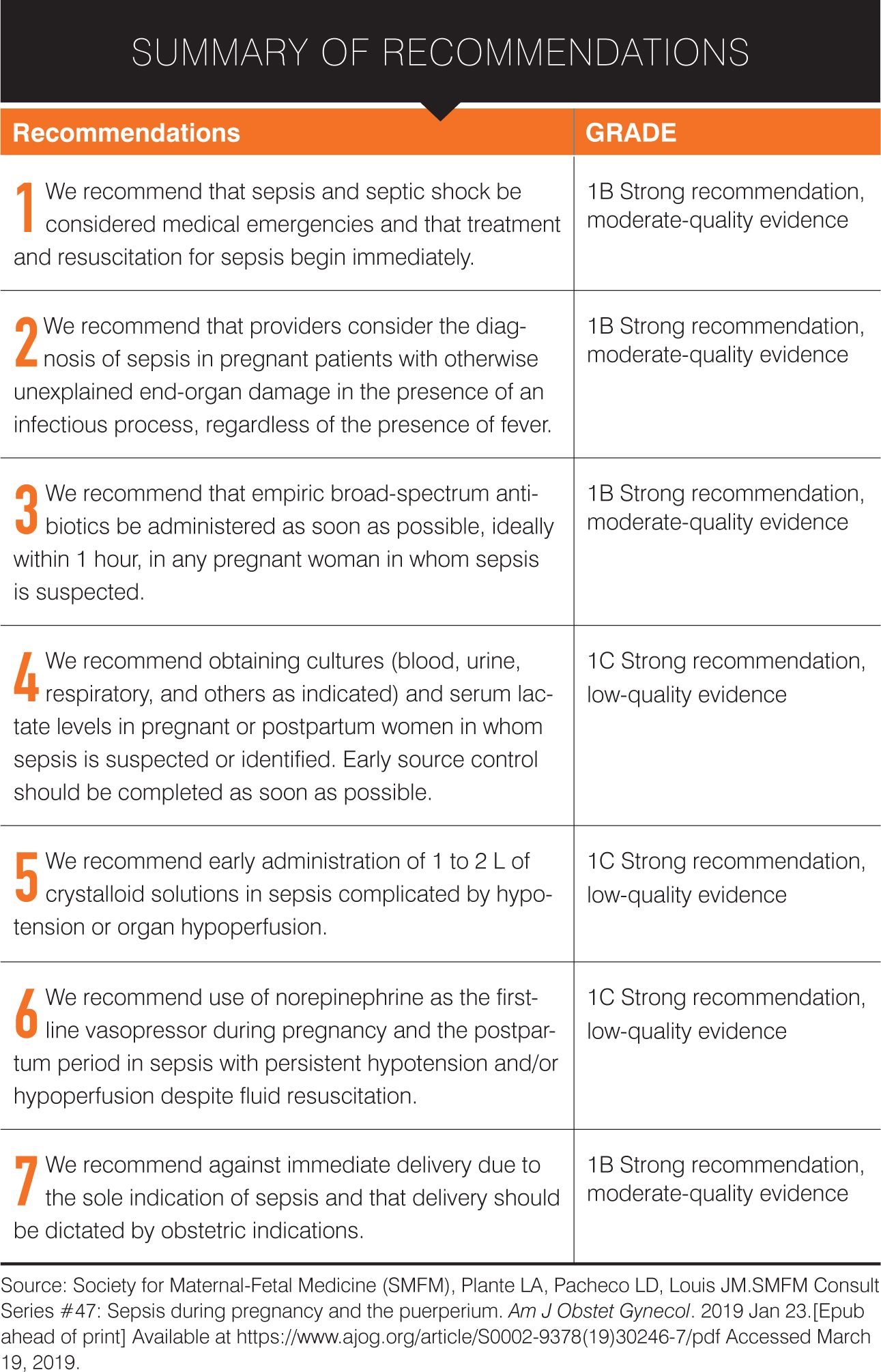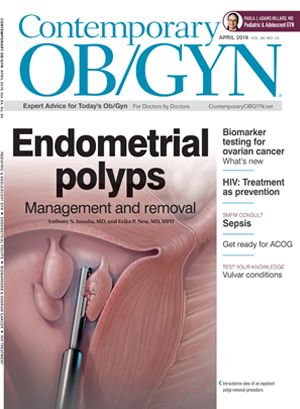Sepsis during pregnancy and the puerperium
Incidence of maternal sepsis appears to be increasing. Here's what ob/gyns need to know about identification and treatment.
©William Kwong-stock.adobe.com

Summary of Recommendations

Maternal sepsis is a significant cause of maternal morbidity and mortality. Recent US data report that maternal sepsis complicates 4 to 10 per 10,000 live births. Incidence of maternal sepsis appears to be increasing; in the United States between 1998 and 2008, rates of severe maternal sepsis and sepsis-related deaths increased 10% per year. Nulliparity, black race, and public or no insurance have been identified as risk factors for pregnancy-associated sepsis. Obstetric risk factors include cesarean delivery, use of assisted reproductive technologies, and multiple gestation. More than 50% of the women who die from sepsis have one or more chronic comorbid conditions, including chronic renal disease, chronic liver disease, and congestive heart failure.
Q| How is sepsis defined and what are the clinical features?
In 2016, The Third Internal Consensus Definitions for Sepsis and Septic Shock task force defined sepsis as “life-threatening organ dysfunction caused by a dysregulated host response to infection.” Organ dysfunction may be objectively defined as an acute increase of two or more points in the Sequential Organ Failure Assessment (SOFA) score. Septic shock can be identified within a clinical construct of sepsis with persistent hypotension requiring vasopressors to maintain mean arterial pressure (MAP) ≥ 65 mm Hg and a serum lactate level > 2 mmol/L despite adequate volume resuscitation.
A brief bedside assessment tool known as the quick SOFA score (qSOFA) can be used to assist in evaluation of suspected sepsis. The qSOFA score evaluates presence of three clinical criteria: systolic blood pressure ≤ 100 mm Hg, respiratory rate ≥ 22/min, and altered mental status. If two or more of these criteria are present, the patient is at increased risk for poor-sepsis related outcomes. These signs should prompt the physician to look carefully for organ dysfunction, start or escalate therapy, increase the acuity of monitoring, and consider transfer to an intensive care unit. Importantly, fever is neither necessary nor sufficient to determine whether sepsis is present.
Q| What is the pathophysiology of sepsis?
Sepsis results from a dysregulated host response to infection resulting in organ damage, and virtually any organ system can be affected. The excessive inflammatory response that occurs with sepsis includes extravasation of albumin and fluid, with resultant intravascular hypovolemia. Cytokine release leads to decreased systemic vascular resistance and increased cardiac output, although up to 60% of patients with sepsis have an ejection fraction below 45% (systolic dysfunction). Septic cardiomyopathy may also manifest with diastolic dysfunction due to cardiac edema and diminished compliance. The noncompliant left ventricle will result in decreased diastolic filling and less stroke volume, increasing risk of pulmonary edema with excessive fluid resuscitation. Tissue ischemia (and dysfunction) results not only from hypotension but also secondary to microvasculature occlusion from microthrombi due to disseminated intravascular coagulation.
Q| How do clinical features of sepsis differ in pregnancy?
Normal human pregnancy is a state of expanded plasma volume, increased cardiac output, and peripheral vasodilation. None of the existing definitions of sepsis account for physiologic alterations of normal pregnancy. When nonpregnant norms are used, either overdiagnosis or underdiagnosis of sepsis may occur. Of the SOFA criteria, those most affected by pregnancy are creatinine and MAP. An obstetric-modified qSOFA has been proposed by the Society of Obstetric Medicine Australia and New Zealand (SOMANZ) and includes systolic blood pressure ≤ 90 mm Hg, respiratory rate > 25/min, and altered mental status. The SOMANZ guidelines also include modifications to laboratory components when applying the SOFA score to pregnancy, including a point value above zero for a creatinine > 90 µmol/L (1.02 mg/dL).
Most important in optimizing outcomes is early recognition of organ dysfunction in the septic patient. In addition to the SOMANZ guidelines described above, there have been other attempts to devise a pregnancy-specific scoring system for sepsis. Evaluation of the “Sepsis in Obstetrics Score,” a combination of maternal temperature, blood pressure, heart rate, respiratory rate, peripheral oxygen saturation, white blood cell count, and lactic acid level as predictors of intensive care unit (ICU) admission for sepsis and modified to account for normal physiologic changes of pregnancy reported a positive predictive value (PPV) of only 16.7% for ICU admission. A prospective validation study of the Sepsis in Obstetrics Score found that a score of 6 or greater had a sensitivity of 64%, specificity of 88%, PPV of 15%, and negative predictive value of 98.6%.
Q| What are the most common infectious etiologies of sepsis?
The source of infection in puerperal sepsis can be either pelvic or nonpelvic. Antepartum cases of sepsis are most commonly nonpelvic in origin, while intrapartum and postpartum cases are more likely to have a pelvic source. In 30% of cases, no source is identified. In the UK Obstetric Surveillance System, clinical laboratory testing was only able to identify the causative microorganism in 64% of maternal sepsis cases, and the clinician could identify the source in only 74%. In 16%, neither the inciting organism nor the source of sepsis was identified.
The most frequently isolated organisms in maternal sepsis are Escherichia coli and group A and group B Streptococcus, although staphylococci, gram-negative and anaerobic bacteria, and many other organisms have been reported. Mixed infections are also possible; in 15% of maternal sepsis deaths in which organisms could be identified, the infection was polymicrobial. Empiric antibiotic choices will be driven by the presumed source, likely microorganisms, and local patterns of antibiotic resistance and should include coverage of anaerobic and aerobic gram-positive and gram-negative bacteria. Hospitals may have specific recommendations in place or guidance may be sought from a consultant in infectious disease or from specialty society guidelines. Antibiotic coverage should be narrowed and focused once culture results are available.
Molecular techniques, such as polymerase chain reaction (PCR)-based systems, can identify inciting organisms not detected by culture-based methods and can provide pathogen identification from blood samples before cultures become positive. PCR testing results are positive in approximately 11% of patients with a clinical suspicion of bacteremia but negative blood cultures.
Q| What is initial management of sepsis?
Imaging is often required when searching for a source of infection. If a specific focus is identified, appropriate steps should be undertaken, such as curettage for retained products of conception or drainage of an abscess. The intervention with the least potential for physiologic derangement should be employed except in cases of necrotizing soft tissue infections, where extensive debridement is required.
Q| What is the role of fluid therapy in sepsis management?
Fluid resuscitation should be part of the initial intervention if hypotension or hypoperfusion is present. Fever, venodilation, and capillary leakage all lead to inadequate preload in the patient with sepsis. The Surviving Sepsis Campaign’s recommendation of an initial bolus of 30 mL/kg of crystalloid may be overly aggressive in pregnancy, where colloid oncotic pressure is lower and risk of pulmonary edema is higher. Patients who are fluid responsive should be identified before further fluid administration (especially after the initial 1 to 2 liters, or 30 mL/kg, have been administered) by dynamic measures of preload. For pregnant women, these include analysis of pulse-pressure variation in the waveform of an arterial line and passive leg raising. The former method is only reliable in sedated individuals receiving positive-pressure, controlled mechanical ventilation and who are in sinus rhythm. A pulse-pressure variation of more than 13% with the respiratory cycle identifies the patient as volume responsive.
For patients who are breathing spontaneously and in sinus rhythm, passively raising the legs 30 to 45 degrees causes an autotransfusion of close to 300 mL of blood from the legs into the chest. After 2 to 3 minutes of passive leg raising, fluid responders will have an increase in cardiac output (utilizing noninvasive cardiac output monitors), while those who do not improve are probably better treated with vasopressors. Passive leg raising may not be useful during the third trimester due to uterine compression of the inferior vena cava and should not be used to guide therapy. In such cases, an increase in cardiac output may be identified by administering a small bolus of fluid (250-500 cc); if cardiac output increases after such an intervention, further fluid administration is likely indicated. Determination of fluid responsiveness using point-of-care ultrasound measurements of the diameter of the inferior vena cava with respiration is most commonly used in patients receiving mechanical ventilation and has not been validated in pregnancy.
Q| When are vasopressors and inotropes indicated?
In hypotensive patients who are not fluid responsive or who are not candidates for further fluid resuscitation (e.g., women who are in pulmonary edema), vasopressors should be utilized to increase blood pressure. The purpose of vasopressors is to constrict the pathologically dilated systemic circulation and maintain adequate perfusion. Current guidelines recommend norepinephrine as the first-line agent with a target MAP above 65 mm Hg, although the latter threshold has not been studied in pregnant women. Determining the target MAP in a septic pregnant patient must be individualized, with consideration of overall organ perfusion. Lower blood pressures may be acceptable during pregnancy provided no signs of hypoperfusion are present (such as altered mental status, oliguria, elevated serum lactate, cold extremities, or evidence of fetal compromise). Early goal-directed therapy is no longer recommended in management of sepsis.
Norepinephrine has been studied in human pregnancy and is often used to maintain blood pressure with regional anesthesia at time of cesarean delivery. Norepinephrine appears to be safe for the fetus, especially at low doses.
Q| When is delivery indicated in pregnant women with sepsis?
Presence of sepsis alone is not an immediate indication for delivery (except in cases of chorioamnionitis). Delivery should be reserved for the usual obstetric indications after stabilization of the woman; there is no evidence that delivery improves maternal outcomes. The primary objective should be hemodynamic supportive therapy for maternal benefit and antimicrobial treatment with appropriate source control of the infection. Corticosteroids for fetal lung maturity are not contraindicated and may be used in sepsis if indicated (regardless of use of hydrocortisone for refractory septic shock). Norepinephrine has been studied in human pregnancy and is often used to maintain blood pressure with regional anesthesia at time of cesarean delivery. Norepinephrine appears to be safe for the fetus, especially at low doses.
Q| What are the maternal and perinatal outcomes associated with sepsis?
The mortality rate for sepsis in pregnant women is difficult to quantify. The few existing studies have reported rates from 1% to 4.6%. Because incidence of and mortality from sepsis are dependent on age, comparisons to the general population depend on finding a similar group of reproductive-age women. In 2012, an analysis from New Zealand and Australia found the mortality rate in young adults aged 44 years and younger to be 8% in the absence of comorbidities.
Preterm delivery is common after critical maternal illness, including sepsis, even when the source is not uterine. An Irish study found that in women with antepartum bacteremia, 69% either miscarried or delivered preterm. The outcome was worse for women with antepartum bacteremia of uterine origin; all delivered within 24 hours of onset. Among women with a nonpelvic source of bacteremia in the antepartum period, 12% miscarried, 33% delivered soon after onset, and the remainder delivered between 1 week and 7 months after onset.
Q| How can deaths from sepsis be prevented?
Among women who died from sepsis, a majority had a delay in care and a delay in escalation of care. Most were afebrile, possibly delaying recognition of presence of sepsis. Even after diagnosis, 73% of women were started on antibiotics that provided inadequate coverage. Implementation of an early warning system may decrease maternal risk. In addition, with publication of the Surviving Sepsis guidelines, early involvement of consultants with expertise in infectious disease may expedite treatment of sepsis and help improve outcomes.

S1E4: Dr. Kristina Adams-Waldorf: Pandemics, pathogens and perseverance
July 16th 2020This episode of Pap Talk by Contemporary OB/GYN features an interview with Dr. Kristina Adams-Waldorf, Professor in the Department of Obstetrics and Gynecology and Adjunct Professor in Global Health at the University of Washington (UW) School of Medicine in Seattle.
Listen
Study shows a healthy prenatal diet could be upstream obesity prevention strategy
December 26th 2024"Our findings support the recommendation of a healthy diet based on the current guidelines (as measured by the HEI) during pregnancy, since it may reduce patterns of infant growth outside reference ranges."
Read More
Early pregnancy cannabis use high in states with recreational legalization
November 11th 2024A population-based time-series analysis California before, during and after legalization show a rising trend in women using cannabis while pregnancy especially when the state has legalized the drug.
Read More
